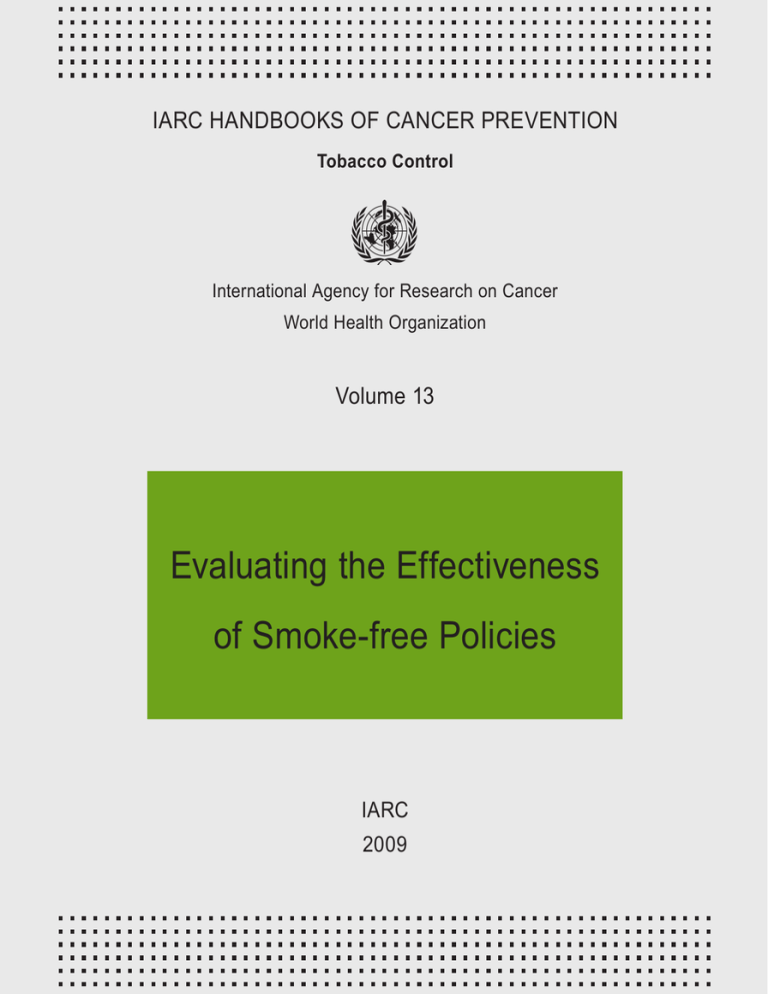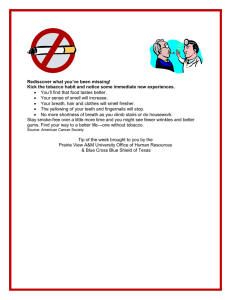
IARC HANDBOOKS OF CANCER PREVENTION
Tobacco Control
International Agency for Research on Cancer
World Health Organization
Volume 13
Evaluating the Effectiveness
of Smoke-free Policies
IARC
2009
IARC HANDBOOKS OF CANCER PREVENTION
Tobacco Control
International Agency for Research on Cancer
World Health Organization
Volume 13
Evaluating the Effectiveness
of Smoke-free Policies
IARC
2009
International Agency for Research on Cancer
The International Agency for Research on Cancer (IARC) was established in 1965 by the World Health Assembly, as
an independently funded organisation within the framework of the World Health Organization. The headquarters of
the Agency are in Lyon, France.
The Agency conducts a programme of research concentrating particularly on the epidemiology of cancer and
the study of potential carcinogens in the human environment. Its field studies are supplemented by biological and
chemical research carried out in the Agency’s laboratories in Lyon and, through collaborative research agreements,
in national research institutions in many countries. The Agency also conducts a programme for the education and
training of personnel for cancer research.
The publications of the Agency contribute to the dissemination of authoritative information on different aspects of
cancer research. Information about IARC publications, and how to order them, is available via the Internet at: http://
www.iarc.fr/en/publications/index.php.
This publication represents the views and opinions of an IARC Working Group on Evaluating the effectiveness of
smoke-free policies which met in Lyon, France, 31 March - 5 April 2008.
iii
IARC Handbooks of Cancer Prevention
Published by the International Agency for Research on Cancer,
150 cours Albert Thomas, 69372 Lyon Cedex 08, France
© International Agency for Research on Cancer, 2009
Distributed by
WHO Press, World Health Organization, 20 Avenue Appia, 1211 Geneva 27, Switzerland (tel: +41 22 791 3264; fax:
+41 22 791 4857; email: bookorders@who.int).
Publications of the World Health Organization enjoy copyright protection in accordance with the provisions of
Protocol 2 of the Universal Copyright Convention. All rights reserved.
The designations employed and the presentation of the material in this publication do not imply the expression of
any opinion whatsoever on the part of the Secretariat of the World Health Organization concerning the legal status
of any country, territory, city, or area or of its authorities, or concerning the delimitation of its frontiers or boundaries.
The mention of specific companies or of certain manufacturers’ products does not imply that they are endorsed or
recommended by the World Health Organization in preference to others of a similar nature that are not mentioned.
Errors and omissions excepted, the names of proprietary products are distinguished by initial capital letters.
The authors alone are responsible for the views expressed in this publication.
The International Agency for Research on Cancer welcomes requests for permission to reproduce or translate its
publications, in part or in full. Requests for permission to reproduce or translate IARC publications – whether for sale
or for noncommercial distribution – should be addressed to WHO Press, at the above address
(fax: +41 22 791 4806; email: permissions@who.int).
Format for Bibliographic Citation
IARC Handbooks of Cancer Prevention, Tobacco Control, Vol. 13: Evaluating the effectiveness of smoke-free
policies (2009: Lyon, France)
IARC Library Cataloguing in Publication Data
Evaluating the effectiveness of smoke-free policies / IARC Working Group on the Evaluation of the Effectiveness of
Smoke-free Policies (2008 : Lyon, France)
(IARC Handbooks of Cancer Prevention ; 13)
1. Neoplasms – prevention & control 2. Program Evaluation 3. Public Policy
4. Smoking Cessation 5. Tobacco Smoke Pollution – legislation & jurisprudence I. IARC Working Group on the
Evaluation of the Effectiveness of Smoke-free Policies II. Series
ISBN 978-92-832-3013-7
ISSN 1027- 5622
iv
(NLM Classification QZ 39)
Table of Contents
List of participants ...............................................................................................................................................................vi
Acknowledgements .............................................................................................................................................................viii
Preface .................................................................................................................................................................................ix
Chapter 1
Overview of Handbook volume 13 .....................................................................................................................................1
Chapter 2
The health effects of exposure to secondhand smoke (SHS) .........................................................................................9
Chapter 3
The evolution of smoke-free policies .................................................................................................................................59
Chapter 4
Impact of smoke-free policies on businesses, the hospitality sector, and other incidental outcomes ........................75
Chapter 5
Public attitudes towards smoke-free policies – including compliance with policies ......................................................93
Chapter 6
Reductions in exposure to secondhand smoke and effects on health due to restrictions on smoking .......................135
Chapter 7
The effect of mandated smoking restrictions on smoking behaviour .............................................................................163
Chapter 8
Home smoking restrictions: effects on exposure to SHS and smoking behaviour .......................................................209
Chapter 9
Summary ..............................................................................................................................................................................253
Chapter 10 Evaluation .............................................................................................................................................................................259
Chapter 11 Recommendations ...............................................................................................................................................................263
Appendices .........................................................................................................................................................................265
References ...........................................................................................................................................................................305
Working procedures ............................................................................................................................................................327
v
List of Participants
John P. Pierce (Chair)
Department of Family
and Preventive Medicine
Moores Cancer Center
University of California, San Diego
3855 Health Sciences Drive,
Room 3065
La Jolla, CA 92093-0901
USA
Esteve Fernández
Tobacco Control Research Unit
Cancer Prevention and Control
Department
Catalan Institute of Oncology
Av. Gran Via 199-203
08907 L’Hospitalet
Barcelona
Spain
Douglas Bettcher
Tobacco Free Initiative
World Health Organization
20, avenue Appia
CH-1211 Geneva 27
Switzerland
Elizabeth Gilpin
Cancer Prevention and Control
Program
Moores Cancer Center
University of California, San Diego
La Jolla, CA 92093-0901
USA
Frank J. Chaloupka
University of Illinois at Chicago
National Bureau of Economic
Review
1747 W. Roosevelt,
Room 558
Chicago, IL 60608
USA
Richard A. Daynard
Northeastern University
School of Law
Public Health Advocacy Institute
400 Huntington Avenue
Boston, MA 02115
USA
vi
Sally Haw
Scottish Collaboration for Public
Health Research and Policy
(SCPHRP) MRC
Human Genetics Unit
Western General Hospital
Crewe Road
Edinburgh
EH4 2XU
Scotland
NHS Health Scotland
Thistle House
91 Haymarket Terrace
Edinburgh
EH12 5HE
Scotland
Andrew Hyland (not attending)
Department of Health Behaviour
Roswell Park Cancer Institute
Elm and Carlton Streets
Buffalo, NY 14263
USA
Jennifer K. Ibrahim
Department of Public Health
Temple University
1301 Cecil B. Moore Avenue
Ritter Annex - 9th Floor - 004-09
Philadelphia, PA 19122
USA
Giovanni Invernizzi
Tobacco Control Unit
National Cancer Institute/SIMG
Via Venezian, 1
20133 Milan
Italy
Karl E. Lund
Norwegian Institute for Alcohol
and Drug Research
PO Box 565 Centrum
0105 Oslo
Norway
Armando Peruga
Tobacco Free Initiative
World Health Organization
20, avenue Appia
CH-1211 Geneva 27
Switzerland
List of Participants
Krzysztof Przewozniak
WHO Collaborating Centre
Department of Cancer Epidemiology
and Prevention
Maria Sklodowska-Curie
Memorial Cancer Center
5, Roentgena Street
02-781 Warsaw
Poland
Jonathan Samet
Department of Epidemiology
Bloomberg School of Public Health
Johns Hopkins University
615 North Wolfe Street
Baltimore, MD 21205-2179
USA
Michelle Scollo (not attending)
School of Public Health A27
University of Sydney
NSW 2006 Sydney
Australia
Nick Wilson
Department of Public Health
University of Otago, Wellington
Box 7343 Wellington South
New Zealand
Alistair Woodward
School of Population Health
University of Auckland
Private Bag 92019
Auckland 1142
New Zealand
IARC Secretariat
Paolo Boffetta (Group Head)
Elisabeth Couto (Rapporteur)
John Daniel (Editor, Plenary Session)
Fabrizio Giannandrea (Rapporteur)
María E. León (Responsible Officer)
Kunnambath Ramadas
Nualnong Wongtongkam (Post-Meeting)
Technical/Administrative
Assistance
Latifa Bouanzi (Library)
Rim Boudjema (Secretarial)
Jennifer Donaldson (Editor)
Roland Dray (Graphics)
Sharon Grant (Library)
Brigitte Kajo (Bibliography)
Georges Mollon (Photography)
Sylvia Moutinho (Secretarial)
Stéphanie Royannais (Layout)
vii
Acknowledgements
The Working Group acknowledges the invaluable help provided in the data preparation presented in this Handbook
by the following researchers: Elizabeth Khaykin (Johns Hopkins University, Baltimore, Maryland, USA), Anita Lal (The
Cancer Council Victoria, Carlton, Victoria, Australia), Birgit Lehner (Tobacco Free Initiative, World Health Organization,
Geneva, Switzerland), Luminita Sanda (Tobacco Free Initiative, World Health Organization, Geneva, Switzerland),
Shaheen Sultana (University of Auckland, Auckland, Australia), Edward Sweda (Public Health Advocacy Institute,
Boston, Massachusetts, USA), and Barbara Zolty (Tobacco Free Initiative, World Health Organization, Geneva,
Switzerland).
The IARC and WHO secretariat are grateful to Sylvia Moutinho (Lifestyle and Cancer Group, IARC) and Miriamjoy
Aryee-Quansah (Tobacco Free Initiative, WHO) and to the staff of the Libraries at the International Agency for Research
on Cancer, Lyon, France and the World Health Organization, Geneva, Switzerland.
viii
Preface
A key intervention in reducing the
burden of disease attributable to
tobacco use is protecting people from
exposure to secondhand tobacco
smoke (SHS). Volume 13 of the
IARC Handbook series on Cancer
Prevention presents the evidence on
the effectiveness of measures enforced at the societal level to eliminate tobacco smoking and tobacco
smoke from the environments where
exposure takes place. This volume
offers a critical review of the evidence
on the economic effects and health
benefits of smoke-free legislation and
the adoption of voluntary smoke-free
policies in households.
“adopt and implement… effective
legislative, executive, administrative
and/or other measures, providing for
protection from exposure to tobacco
smoke in indoor workplaces, public
transport, indoor public places and,
as appropriate, other public places.”
(WHO, 2005). Guidelines adopted
by the Conference of the Parties
to assist Parties in meeting their
obligation under this article of the
treaty, clearly state that this requires
“the total elimination of smoking and
tobacco smoke in a particular space
or environment in order to create
a 100% smoke-free environment.”
(WHO, 2007a).
SHS
contains
nicotine,
carcinogens, and toxins and the
IARC (2004) concluded that exposure
to SHS is carcinogenic to humans.
Article 8 of the WHO Framework Convention on Tobacco Control (FCTC)
recognises “that scientific evidence
has unequivocally established that
exposure to tobacco smoke causes
death, disease and disability.” It
mandates Parties to this treaty to
Today, 164 countries have
ratified the WHO FCTC and more
are expected to do so in the future.
As a result, countries around the
world are working towards designing,
implementing, and enforcing legal
measures aimed at creating 100%
smoke-free environments in public
and workplaces. The relevant content
of this Handbook will serve as guiding
principles to those countries.
The literature reviewed for this
Handbook was published from 1990
mostly up to April 2008, when the
meeting took place to conduct the
evaluation of the gathered evidence.
The Working Group drafting the
volume acknowledged the need
to document the enforcement and
reach of smoke-free policies in many
developing countries where smokefree legislation either does not exist
or is not effective, translating into millions of people, particularly children,
who are routinely exposed to SHS.
Globally, about half of never smokers
are exposed to tobacco smoke in
different settings: work (including
hospitality venues), home, cars, and
other means of transportation. About
10-15% of lung cancers in never
smokers may be attributed to SHS
(Boyle & Levin, 2008). Comprehensive
smoke-free legislation, as described
in the guidelines of Article 8 of the
WHO FCTC, will lead signing Parties
towards removing this major cause of
disease and death worldwide.
ix

